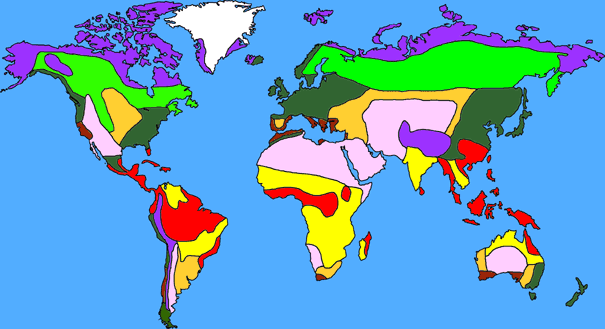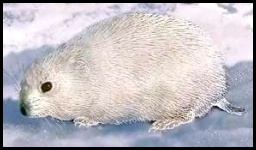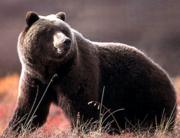2.16.2012
Anthropogenic Threats
Impact from Human Workings on the Tundra Environment
Housing development doesn't seem to be a major problem in the
Tundra, with the weather being cold and all. It is seemingly a technical
challenge to use efficient sewage treatment in a cold environment. The biggest
threats of humans to the tundra are airborne pollutants, which have brought DDT
and PCB's (industrial wastes) to even the most remote areas in this region.
The biggest threat of all comes from oil and gas development.
The Arctic National Wildlife just so happens to be sitting on top of an about 6
month supply of oil.
Despite the great difficulty of extracting this oil,
corporate interests still persist to drill here. Global warming also plays a
key role in the future of the tundra biome as the planet warms up, the
permfrost will continue to melt and tundra ecosystems will fall apart. Inside
the permafrost as well, is dead plant material which will release CO2 into the
atmosphere upon decaying, thus accelerating global warming.
Soil and Ground Conditions
When snow above the
active layer melts, the water remains on the surface of the soil. Water cannot
be absorbed by the permafrost (layer of permanent frozen ground below the
active layer) and leaves the top layer wet and soggy. Evaporation of water is
also impossible because of the tundra's cool air. The arctic tundra landscape
is formed from the freezing and refreezing of this soggy soil. There are five
distinguishable types of land formations by freezing water: pingos, frost
boils, bumpy ground, polygons, and stripes.
Pingos are hills formed by pools of
water that were trapped by permafrost and polygons are geometric land shapes
outlined by cracks filled with water. The process, in which the water causing
the tundra's soggy ground flows downhill, is called solifluction.
Where is the Arctic Tundra?
Tundra Climate
It is mainly located in the poleward region of about 60 degrees North latitude. The average temperature of the tundra per year is 16 degrees F. The highest, warmest temperature it can get is 45 degrees and the coldest is 10 degrees below 0. This biome is made up of most of the earth's coldest regions on Earth.
It is mainly located in the poleward region of about 60 degrees North latitude. The average temperature of the tundra per year is 16 degrees F. The highest, warmest temperature it can get is 45 degrees and the coldest is 10 degrees below 0. This biome is made up of most of the earth's coldest regions on Earth.
2.14.2012
Lemmings
Basic Facts
Length: 3 to 6 inches
Color: Thick gray or brown, white during the winter
Location: North America, Asia, Europe, Alaska
Food: They mostly eat plants such as mosses, grasses, herbs, shoots, and lichen. They have sharp teeth that allows them to gnaw through tangle of roots, mosses, and soil.
Lifespan: Live less than 2 years, they can have 3 to 7 babies
Enemies: Foxes, Weasels, Hawks, Owls, Gyrfalcon, and Wolves
2.10.2012
Grizzly Bear
Basic Facts
Size: They can weigh up to 704 lbs, be over 8 feet in length, and stand 3 1/2 feet high at the shoulders.
Location: North America, Europe, Asia
Color: Most are brown, black, or blond
Lifespan: 25 years
Habitat: make dens under rocks, in hollow trees, in caves
Enemies: None
Grizzly bears have amazing physical strength and are surprisingly fast over short distances. They are very aggressive and have no trouble driving away predators like wolves and mountain lions. The grizzly also has a great sense of smell.
|
The grizzly has a heavy, stout body, a big head, and short tail.
It has a distinctive hump between its shoulder blades.
Arctic Fox
Basic Facts
Length: 21 – 22 inch
Weight: 8.75 lbs.
Social Unit: Group
Location: N. Canada, Alaska, Greenland,
N. Europe, N. Asia
Status: Common
The Arctic fox comes in two sort of shades, one being white-phase and the other being blue-phase, distinguishing the kind of color they are during the winter.
The pure white helps to camouflage the fox in the snow and ice to protect from predators and enhance their
ability to sneak up on prey. These white foxes mainly reside in places that are
open, treeless plains and grassy hillocks. Foxes of the blue-phase are often
found in coastal regions and habitats near shrubbery. During the winter, these
foxes are pale gray-brown with tinges of blue.
During the summer months, the coat of an Arctic fox changes quite dramatically. It is now half as thick, and the color changes as well. For the white-phase fox, it becomes a gray-brown, while the blue-phase fox become a darker brown color.
Works Cited
"Tundra Climate." Blue Planet Biomes. Web. 13
Feb. 2012. <http://www.blueplanetbiomes.org/tundra_climate_page.htm>.
"9(k) Characteristics of
the Earth's Terrestrial Biomes." Geography
: Physical Geography. Web. 15 Feb. 2012.
<http://www.physicalgeography.net/fundamentals/9k.html>.
"Arctic and Alpine Tundra
Soil and Land Formation." Biomes.
ThinkQuest. Web. 15 Feb. 2012.
<http://library.thinkquest.org/C0113340/main.php?section=biomes&topic=tundra&subtopic=soilland>.
Snowy Owl. Youtube.com.
Web. 15 Feb. 2012. <http://www.youtube.com/watch?feature=player_embedded&v=jN2Hpd_W9g8>.
"Tundra Animals : Artic
Fox." Tundra Animals
Plants. Web. 14 Feb. 2012.
<http://tundra-animals-plants.blogspot.com/2011/05/tundra-animals-artic-fox.html>.
"Tundra Animals : Snowy
Owl." Tundra Animals
Plants. Web. 14 Feb. 2012.
<http://tundra-animals-plants.blogspot.com/2011/05/tundra-animals-snowy-owl.html>.
Subscribe to:
Posts (Atom)
























